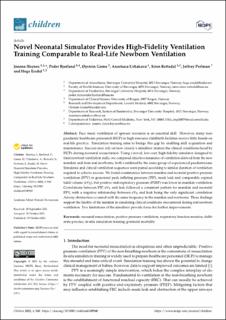| dc.contributor.author | Haynes, Joanna | |
| dc.contributor.author | Bjorland, Peder Aleksander | |
| dc.contributor.author | Gomo, Øystein | |
| dc.contributor.author | Ushakova, Anastasia | |
| dc.contributor.author | Rettedal, Siren | |
| dc.contributor.author | Perlman, Jeffrey M. | |
| dc.contributor.author | Ersdal, Hege Langli | |
| dc.date.accessioned | 2021-11-11T09:13:44Z | |
| dc.date.available | 2021-11-11T09:13:44Z | |
| dc.date.created | 2021-11-05T12:24:06Z | |
| dc.date.issued | 2021-10 | |
| dc.identifier.citation | Haynes, J., Bjorland, P., Gomo, Ø. et al. (2021) Novel neonatal simulator provides high-fidelity ventilation training comparable to real-life newborn ventilation. Children, 8 (10), 940. | en_US |
| dc.identifier.issn | 2227-9067 | |
| dc.identifier.uri | https://hdl.handle.net/11250/2829028 | |
| dc.description.abstract | Face mask ventilation of apnoeic neonates is an essential skill. However, many non-paediatric healthcare personnel (HCP) in high-resource childbirth facilities receive little hands-on real-life practice. Simulation training aims to bridge this gap by enabling skill acquisition and maintenance. Success may rely on how closely a simulator mimics the clinical conditions faced by HCPs during neonatal resuscitation. Using a novel, low-cost, high-fidelity simulator designed to train newborn ventilation skills, we compared objective measures of ventilation derived from the new manikin and from real newborns, both ventilated by the same group of experienced paediatricians. Simulated and clinical ventilation sequences were paired according to similar duration of ventilation required to achieve success. We found consistencies between manikin and neonatal positive pressure ventilation (PPV) in generated peak inflating pressure (PIP), mask leak and comparable expired tidal volume (eVT), but positive end-expiratory pressure (PEEP) was lower in manikin ventilation. Correlations between PIP, eVT and leak followed a consistent pattern for manikin and neonatal PPV, with a negative relationship between eVT and leak being the only significant correlation. Airway obstruction occurred with the same frequency in the manikin and newborns. These findings support the fidelity of the manikin in simulating clinical conditions encountered during real newborn ventilation. Two limitations of the simulator provide focus for further improvements. | en_US |
| dc.language.iso | eng | en_US |
| dc.publisher | MDPI | en_US |
| dc.rights | Navngivelse 4.0 Internasjonal | * |
| dc.rights.uri | http://creativecommons.org/licenses/by/4.0/deed.no | * |
| dc.subject | pediatri | en_US |
| dc.subject | ventilasjon | en_US |
| dc.title | Novel neonatal simulator provides high-fidelity ventilation training comparable to real-life newborn ventilation | en_US |
| dc.type | Peer reviewed | en_US |
| dc.type | Journal article | en_US |
| dc.description.version | publishedVersion | en_US |
| dc.rights.holder | © 2021 by the authors | en_US |
| dc.subject.nsi | VDP::Medisinske Fag: 700::Klinisk medisinske fag: 750::Pediatri: 760 | en_US |
| dc.source.pagenumber | 12 | en_US |
| dc.source.volume | 8 | en_US |
| dc.source.journal | Children | en_US |
| dc.source.issue | 10 | en_US |
| dc.identifier.doi | 10.3390/children8100940 | |
| dc.identifier.cristin | 1951754 | |
| dc.source.articlenumber | 940 | en_US |
| cristin.ispublished | true | |
| cristin.fulltext | original | |
| cristin.qualitycode | 1 | |

